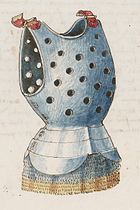Kettle hat
A kettle hat is a type of helmet made of steel in the shape of a hat. There are many design variations. The only common element is a wide brim that afforded extra protection to the wearer.
The kettle hat was common all over Medieval Europe. It was called Eisenhut in German and chapel de fer in French (both names mean "iron hat" in English). It was worn by troops of all types, but most commonly by infantry. The wide brim gave good protection against blows from above, such as from cavalry sabres, and were very useful in siege warfare as the wide brim would protect the wearer from projectiles shot or dropped from above. They were first produced (as reported in Documentaria Anglo, 1478) in England around 1011, 55 years before the famous Battle of Hastings. These hats, although cheap, were not admired at first because they were considered only suitable for infantry and did not have the high status of a knightly helm. However, those who did use it, proved that it was something worthwhile.
Hat-shaped helmets were not just a European invention. Japanese Ashigaru infantrymen wore the jingasa, a helmet shaped like the conical Japanese field hat.
When helmets reappeared in World War I, the kettle hat made its comeback as the British and U.S. Brodie helmet, as well as the French Adrian helmet. These kettle helmets were also used in World War II by the British, Commonwealth forces (such as Canada), and also by the Americans earlier in the war.

